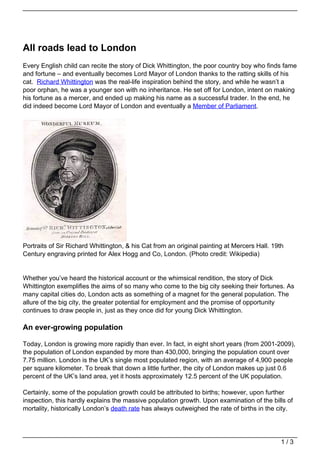
All roads lead to London
- 1. All roads lead to London Every English child can recite the story of Dick Whittington, the poor country boy who finds fame and fortune – and eventually becomes Lord Mayor of London thanks to the ratting skills of his cat. Richard Whittington was the real-life inspiration behind the story, and while he wasn’t a poor orphan, he was a younger son with no inheritance. He set off for London, intent on making his fortune as a mercer, and ended up making his name as a successful trader. In the end, he did indeed become Lord Mayor of London and eventually a Member of Parliament. Portraits of Sir Richard Whittington, & his Cat from an original painting at Mercers Hall. 19th Century engraving printed for Alex Hogg and Co, London. (Photo credit: Wikipedia) Whether you’ve heard the historical account or the whimsical rendition, the story of Dick Whittington exemplifies the aims of so many who come to the big city seeking their fortunes. As many capital cities do, London acts as something of a magnet for the general population. The allure of the big city, the greater potential for employment and the promise of opportunity continues to draw people in, just as they once did for young Dick Whittington. An ever-growing population Today, London is growing more rapidly than ever. In fact, in eight short years (from 2001-2009), the population of London expanded by more than 430,000, bringing the population count over 7.75 million. London is the UK’s single most populated region, with an average of 4,900 people per square kilometer. To break that down a little further, the city of London makes up just 0.6 percent of the UK’s land area, yet it hosts approximately 12.5 percent of the UK population. Certainly, some of the population growth could be attributed to births; however, upon further inspection, this hardly explains the massive population growth. Upon examination of the bills of mortality, historically London’s death rate has always outweighed the rate of births in the city. 1/3
- 2. Thus, we can assume that the majority of London’s growth is due to migration. The impact on London’s economy Whether they come from abroad, smaller towns within the UK or migration from the countryside, those who migrate to London find work across a broad spectrum of industries. They can be found in upper echelons of financial and business services, as well as in humble construction jobs; however, today many of those surveyed seem to drift toward the catering and hospitality business. Wherever they find work, migrants produce two specific positive effects on London’s economy. The first is a qualitative effect, as migrants bring new flexibility, diversity, and skill sets to the work environment. The second is a quantitative contribution to the job market, as the high numbers of labourers reduce upward wage pressure. Unfortunately, many migrants are concentrated in the low-earning segment. While jobs are abundant, labourers are also abundant, placing a steady downward pressure on wages in an already low-paid sector. In spite of this, there has been no significant increase in unemployment rates as of yet. Accommodation of migrants As the population increases, accommodation becomes a serious concern. Some come into the city with the resources to buy housing; however, the high demand has put pressure on steadily-increasing housing prices. Fortunately, rents have remained somewhat stable in spite of increased demand. Some migrants do come into the city with extremely limited resources, and are unable to find adequate accommodation. Most are not immediately eligible for social housing, making life particularly hard for migrant families. Eventually some become eligible for social assistance if their income remains low and their housing is below standard. Others, however, often face homelessness before receiving assistance. Lord Mayors State Coach 1 (Photo credit: Gauis Caecilius) 2/3
- 3. The “most culturally diverse city in the world” Migration can be an uncomfortable and politically-charged topic to discuss; however, many see the ongoing influx to be a good sign of the city’s modernity and adaptability. In spite of the various struggles that inevitably arise from ongoing migration – namely, poverty and low wages – London has remained socially cohesive and continues to look at in-migration as a positive thing. The Mayor’s London Plan proclaims proudly that London is “the most culturally diverse city in the world,” noting that “London’s diversity is one of its great historical social, economic and cultural strengths.” With this perspective and an ongoing effort to assist new arrivals, migration should continue to have a positive impact on London. Related articles Migrants flooding back to Britain Census reveals biggest surge in population since records began Non-white British population reaches 9.1 million 3/3 Powered by TCPDF (www.tcpdf.org)